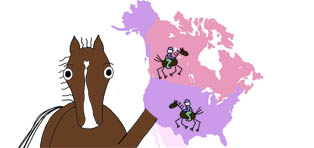By Edited Press Release • Jan 29, 2013 • Article #31277
The Colorado Department of Agriculture is investigating one confirmed case of equine herpesvirus-1 (EHV-1) within the state. A quarantine has been placed on seven horses, including the index case, and a hold order has been placed on six additional horses who might have had direct contact.
The affected horse, a 6-year-old gelding from Texas, is part of a team of Quarter Horses used during the National Western Stock Show (NWSS) rodeo (which took place Jan. 12-27 in Denver) to pull a stagecoach during rodeo performances. The horse began showing clinical signs of disease Jan. 27 and was transported to the Colorado State University Veterinary Teaching Hospital for diagnosis and treatment. The EHV-1 diagnosis was confirmed Jan. 28.
The affected horse is isolated and in stable condition. The other horses from the team are under quarantine at the NWSS coliseum and hold orders have been placed on other horses who might have had direct contact.
"The department is taking quick and appropriate actions to investigate, control, and mitigate this disease," said Colorado State Veterinarian Keith Roehr, DVM. "We will continue to trace the potential contacts of this horse in order to protect Colorado's equine industry."
The affected horse was housed in the coliseum at the NWSS from January 7 to 28. Neither the gelding nor the rest of the team had any contact with horses being housed and shown in the Events Center and the Hall of Education. Horse owners who traveled to the NWSS and participated in events in the coliseum are urged to monitor their horses for clinical signs and contact their veterinarian immediately if their horse becomes ill or has a fever. Owners who have horses with clinical signs consistent with neurologic EHV-1 infection should consult their veterinarian.
Although it's not transmissible to humans, EHV-1 is highly contagious among horses and camelids, and it is generally passed from horse to horse via aerosol transmission (when affected animals sneeze/cough) and contact with nasal secretions. The disease can cause a variety of ailments in equines, including rhinopneumonitis (a respiratory disease usually found in young horses), abortion in broodmares, and myeloencephalopathy (EHM, the neurologic form).
Myeloencephalopathy is characterized by fever, ataxia (incoordination), weakness or paralysis of the hind limbs, and incontinence. Should a horse with potential EHV-1 exposure display any of the aforementioned clinical signs, a veterinarian should be called to obtain samples and test for the disease.
EHV-1 was also diagnosed in Douglas County, Colo., in 2012. In early May, one horse tested positive for EHV-1. Prior to exhibiting signs of the disease, the affected horse had recently traveled to Colorado from Iowa. The Douglas County horse was euthanized after showing severe neurologic signs associated with the disease.

No comments:
Post a Comment